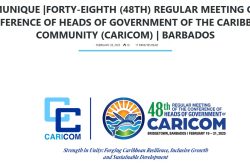On 30 April 2012, the National Assembly approved the Estimates of Expenditure for 2012 of $172 billion against the Government’s request of $192.8 billion, a reduction of $20.8 billion. Accordingly, the Minister of Finance amended the Appropriation Bill to reflect the downward adjustment, the Assembly approved the amended Bill, and the President gave his assent to it. The Government nevertheless challenged the Assembly’s decision on the grounds that: (a) it acted unconstitutionally; and (b) the Assembly could either approve the budget or reject it, but not reduce it.
Constitutional and legal requirements
Article 218 of the Constitution provides for the Minister of Finance or any other Minister designated by the President to prepare and lay before the Assembly estimates of revenue and expenditure of Guyana for each year. When the Assembly approves the Estimates, the Minister introduces an Appropriation Bill to provide for issues from the Consolidated Fund.
Both the Constitution and the FMA Act are silent on the sequence of events between the time the Estimates are laid, and their approval by the Assembly. The Constitution tends to deal with the generality of the matter under consideration, and the details are normally dealt with by way of legislation. For example, Article 220(1) relating to the Contingencies Fund uses the words “urgent need for expenditure for which no other provision exists” while the FMA refers to not only “urgent and unforeseen” but also “unavoidable”. The Act also identifies three additional criteria: (a) no moneys have been appropriated or the sum appropriated is insufficient; (b) moneys cannot be reallocated; or (c) the expenditure cannot be deferred without injury to the public interest.
 In the case of the Estimates, the legislators appeared to step aside when framing the FMA Act to allow for the Assembly’s rules of procedure to take effect. Article 165 (1) of the Constitution states that, subject to the provisions of the Constitution, the National Assembly may regulate its own procedure and may make rules for that purpose. The Standing Orders are the rules of procedure of the Assembly. Amended in 2011, they set out the procedure for consideration of the estimates of expenditure. After the Minister lays the Estimates in the Assembly, he moves a motion for the approval of the said Estimates. In addition, Rule 76(4) provides for any member to move a motion for an amendment to a Head of Expenditure to reduce the sum allotted in respect of any item. It was on this basis that the Assembly reduced the 2012 Estimates. The same happened in respect of the 2013 Estimates.
In the case of the Estimates, the legislators appeared to step aside when framing the FMA Act to allow for the Assembly’s rules of procedure to take effect. Article 165 (1) of the Constitution states that, subject to the provisions of the Constitution, the National Assembly may regulate its own procedure and may make rules for that purpose. The Standing Orders are the rules of procedure of the Assembly. Amended in 2011, they set out the procedure for consideration of the estimates of expenditure. After the Minister lays the Estimates in the Assembly, he moves a motion for the approval of the said Estimates. In addition, Rule 76(4) provides for any member to move a motion for an amendment to a Head of Expenditure to reduce the sum allotted in respect of any item. It was on this basis that the Assembly reduced the 2012 Estimates. The same happened in respect of the 2013 Estimates.
Chief Justice’s preliminary ruling
The Chief Justice upheld the Government’s position on both grounds, no doubt basing his ruling on the words “When the estimates of expenditure (…) have been approved by the Assembly”. This interpretation, however, overlooks the several actions that the Assembly takes before it approves of the Estimates. Indeed, the use of the word “When” would suggest that the Constitution recognizes these actions. One such action is a downward amendment to the estimates. If Article 218(2) had used the words “estimates of expenditure as presented”, the Chief Justice’s interpretation would have been in order.
If the light of the ruling, there is no need for: the annual ritual of the budget speech; the general debate that follows; the National Assembly resolving itself into the Committee of Supply; and the scrutiny of each proposed head of expenditure and putting it to the vote for approval. One could very well argue that these acts are unconstitutional. Within minutes, the presentation and approval of the Estimates can take place, instead of wasting not only the time of legislators but also scarce taxpayers’ resources. The purpose of the budget speech and the general and specific debates is to enable the legislators to reflect on the merits of the arguments for and/or against any amendments to the Estimates and to take the necessary action to do so.
The Chief Justice did suggest that, in view of the new configuration in the Assembly and order to overcome any disagreement, it would be appropriate for the Minister to rework the budget instead of the Assembly. If the Assembly were to do so, in effect it would be approving its own budget. It follows that that if the Minister declines to rework the budget based concerns expressed by the Assembly, the latter has no other option than to reject the budget in its entirety. This may very well precipitate a constitutional crisis.
The Chief Justice further ruled that the Court could not grant any relief since the Government had amended the Appropriation Bill to reflect the reduction in the budget. The amended Bill was passed by the Assembly and assented to by the President, and therefore the Court could not invalidate such actions, except in the case of the Ethnic Relations Commission (ERC). The Court ruled that the Minister could withdraw sums from the Consolidated Fund to restore the ERC’s budget. In no other situations did the Court rule that sums over and above what is contained in the Appropriation Act could be withdrawn from the Consolidated Fund to restore the budget as presented. Only an Appropriation Act can authorize the Minister to make withdrawals from the Consolidated Fund.
In an apparent misreading of the preliminary ruling, the Minister went ahead and restored the original budget by authorizing withdrawals from the Consolidated Fund as well as advances from the Contingencies Fund. This action has serious implications in that it not only undermined the authority of Parliament to approve public expenditure but it is also a violation of Article 218 of the Constitution since only an Appropriation Act can authorize the Minister to withdraw funds from the Consolidated Fund. As it now stands, expenditure totalling $1.797 billion has been incurred in 2012 and 2013 that remains unauthorized. This is unprecedented and a significant blemish in the history of public accountability in Guyana, perhaps second to the ten-year gap in public accountability at the national level during the period 1982 to 1991.
The Chief Justice made reference to the use of the Contingencies Fund as an option to restore the budget but only to the extent that the criteria for withdrawals are met. He argued that the extension contained in the FMA Act to include “unavoidable and unforeseen” is ultra vires Article 221(1) of the Constitution but did not make a ruling as such, as the Court was not requested to do so. He nevertheless suggested that it is for the Minister to make that judgment, and not the Court, as regards the criteria to be used in making advances from the Contingencies Fund.
Chief Justice’s final ruling
On 29 January 2014, some 18 months later, the Chief Justice handed down his final ruling on the matter. It is unclear why he took so long to do so, and the ruling came just two months ahead of the presentation of the 2014 Estimates in the National Assembly. There is therefore not enough time for the Assembly to file an appeal and to obtain a ruling from the Court of Appeal. The ruling reaffirmed the Chief Justice’s preliminary ruling that the Assembly does not have the power to amend the budget as presented. It, however, did not include the comments the Chief Justice had made on the Contingencies Fund, and one suspects that he had second thoughts about the words “unavoidable and unforeseen” in the FMA Act being ultra vires the Constitution.
Article 171(2) precludes the Assembly from proceeding with a Bill or a motion that, among others, imposes a charge on the Consolidated Fund or any other public fund, or for altering any such charge otherwise than by reducing it, without the Cabinet’s consent. In other words, it is permissible for a Bill or a motion to be introduced to reduce a charge on the Consolidated Fund without the approval of Cabinet. Any such Bill or motion, however, must relate to an existing charge and not to a proposed charge. The Chief Justice has confirmed this in his ruling, except that his interpretation is that only a Bill, not a motion, can reduce such a charge.
The Chief Justice also ruled that the Assembly could not rely on the Standing Orders as the basis for reducing the Estimates. In his view, such orders are not written law but merely internal domestic rules. He concluded that the Committee of Supply has acted unlawfully and unconstitutionally in purporting to reduce or cut the Estimates of Expenditure and that the power of the Assembly is limited to giving or withholding its approval.
Conclusion
The Chief Justice has ruled that the decision of the Assembly to amend the Estimates of Expenditure for 2012 is unconstitutional and that the Standing Orders permitting this have no legal effect. This ruling has far-reaching implications and throws the entire budget process in disarray. The way out is for the Assembly to appeal the ruling. However, until such time that this happens and a decision handed down, the Assembly is obliged to respect the Chief Justice’s rule.
A possible way out is this. If the Assembly has strong views about the 2014 Estimates and the Minister will not budge, it would be better for the Assembly to approve the Estimates in the first place. When the President assents to the related Appropriation Bill, any member of the Assembly can then present another Bill in the National Assembly to reduce the charge to the Consolidated Fund where he/she has a reservation on any Head of expenditure contained in the Appropriation Act. Article 172(2) of the Constitution supports this course of action.









